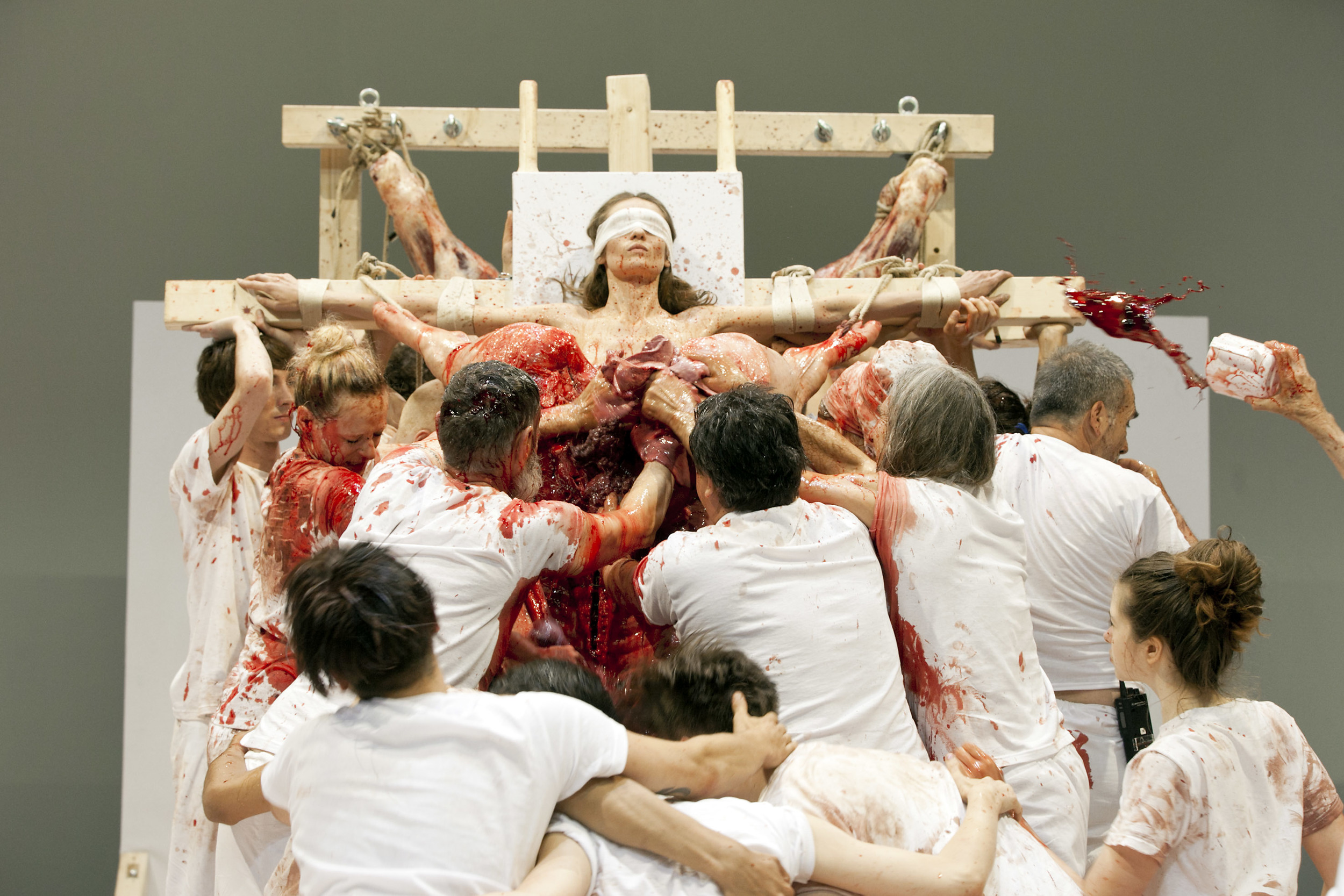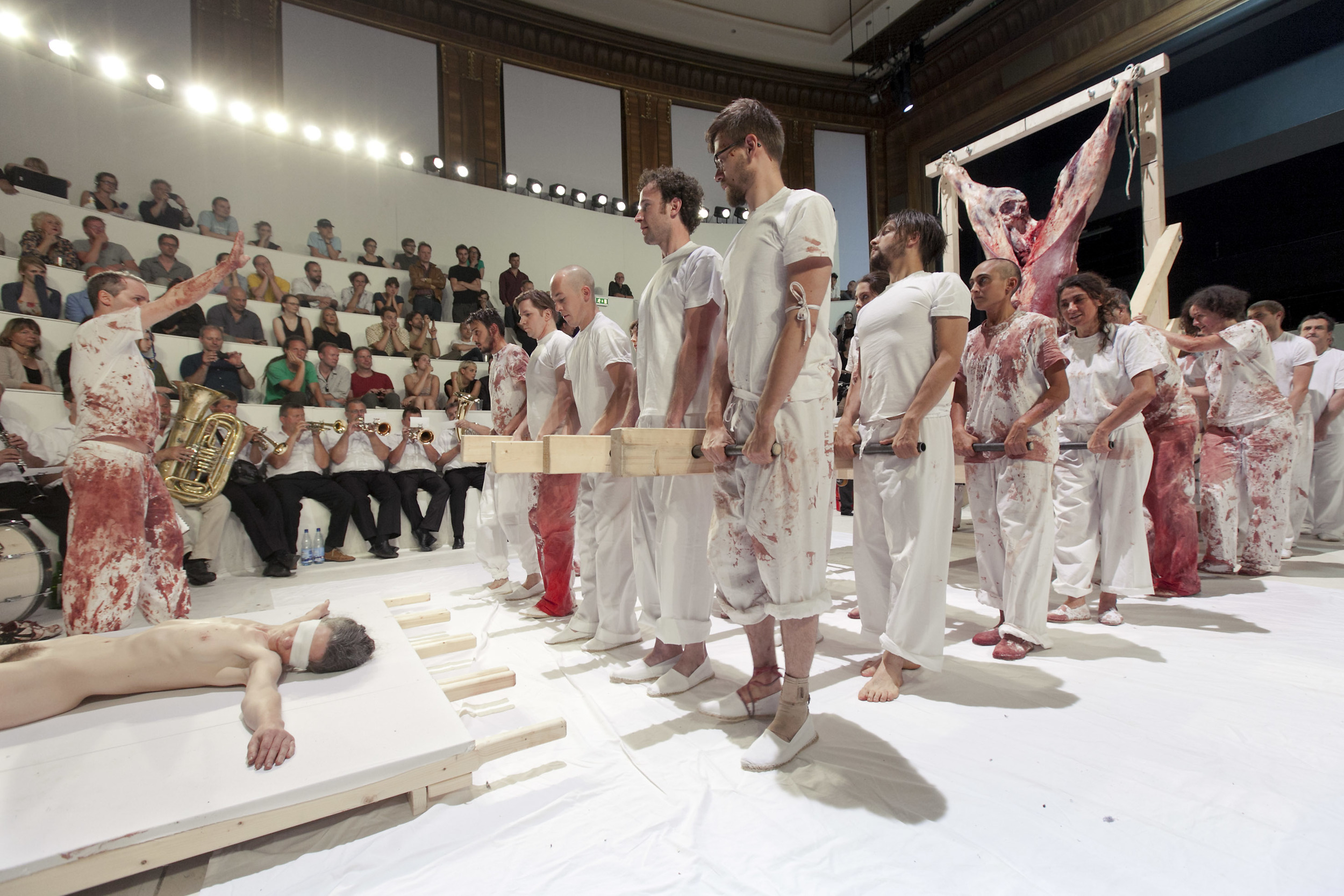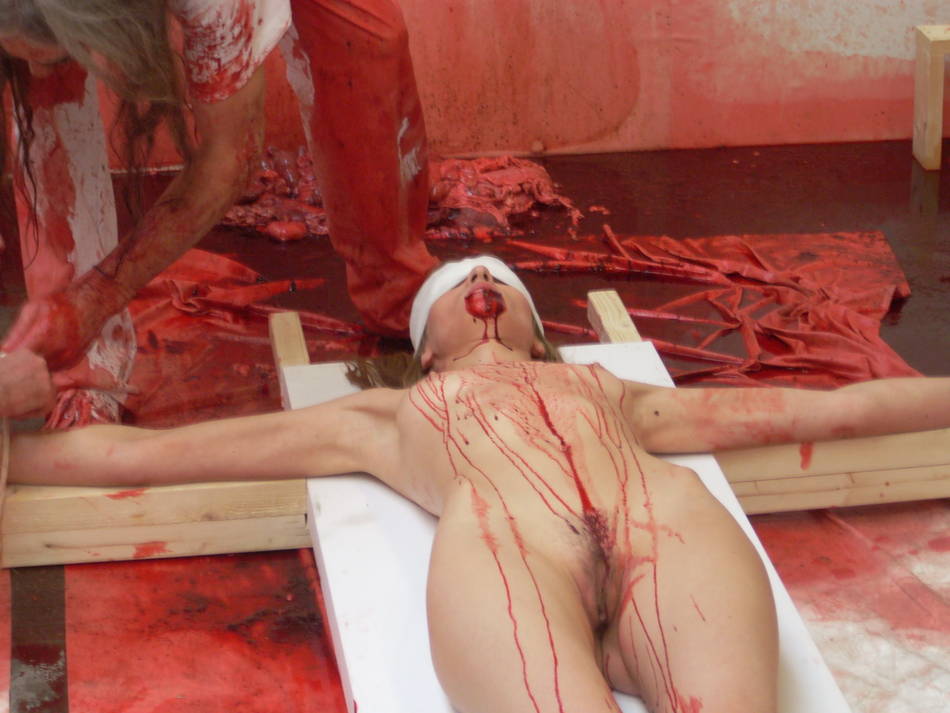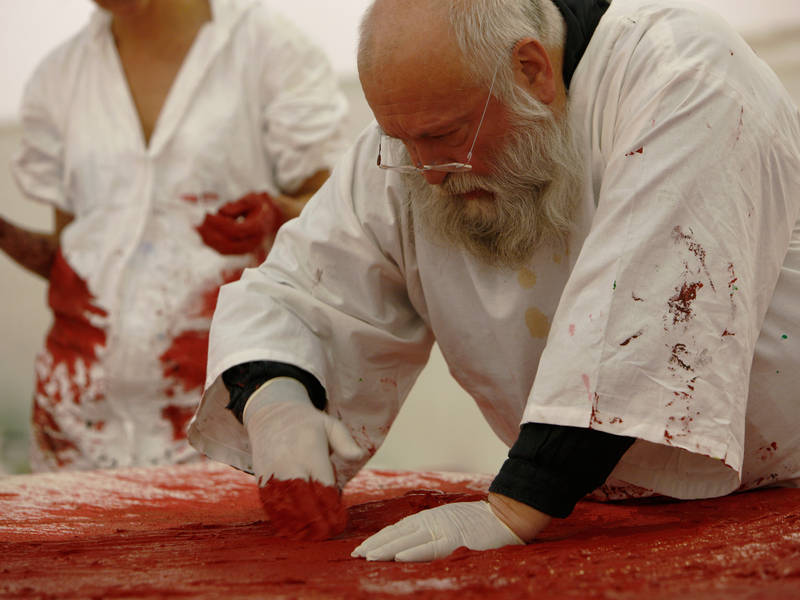Herman Nitsch is considered the last of the great ‘Actionists.’ Together with fellow Austrian artists Günter Brus, Otto Mühl, Rudolf Schwarzkogler, he developed what would become one of the most violent and “depraved” artistic movements of the 20th century. In reaction to a complacent post-war society, Nitsch aimed for realism…shocking, brutal realism, which he insists is only a mirror to man’s own innate brutality and thirst for violence and defilement. His performances, which are held under the title of The Orgies Mysteries Theater, were so shocking and real, that he has been arrested multiple times and even exiled from his own country. His action performances, or “aktionens,” vary in length – sometimes they last several days – but they always convey a sense of pagan ritual, replete with human and animal sacrifices, copulation, blood drinking and bloodletting, disembowelment, intestines spilling from carcasses, dance, music, and audience participation. In one filmed performance, held in Germany in 1970, you can find Nitsch disemboweling a goat, removing the intestines, forcing participants to drink the blood, placing a female participant on a crucifix and then inserting his penis into her vagina through the entrails. In 1972, he acquired the Prinzendorf Castle – ironically from the Catholic Church. To this day, he lives and works there and performs his orgiastic ‘actions’ there. Currently, he is having a major retrospective, of sorts, in Palermo, Italy at the ZAC (Zisa Contemporary Art) Spaces, which is housed in a former industrial space that used to make furniture and airplanes. The show, which is a re-envisioning of his canceled retrospective in Mexico City, will include 40 canvases, numerous photos, as well as videos documenting some of Nitsch’s most important actions over the past few decades. A multi-floor “Pharmacy” filled with fetish objects will also be on view. Like many of his exhibitions, there is a petition to have it shut down. As of writing this, the petition has close to 70,000 supporters – with only 5,000 more signatures to go. We’ll see who has the last word – the exhibition has already been on view for a few weeks. Autre was fortunate enough to have a chat with Hermann Nitsch from his studio in Vienna – our conversation ranged from development of The Orgy Mystery Theater, how the artist embraces his work in the face of possible jail time, the success of his current show in Palermo and what he likes to do for fun.
Oliver Kupper: You say that actionism wasn’t a group, but what do you think was in the atmosphere that motivated you and other artists associated with the movement to create the work they started to create?
Hermann Nitsch: The question of the development of art is also a question of society. In Vienna, it was very conservative. We wanted to make a new art—new expressions of art—in an art world that was, for us, traditional. Abstract expressionism was happening, a new form of art that was very important for us. I would say that’s what moved us together.
OK: Can you talk a little bit about the beginnings of The Orgies Mysteries Theatre ?
HN: I have been asked for thirty, forty years about the development of my theater, and I’m still not able to explain this. It involved the whole art of painting, of abstract expressionism. Traditional theater began with the Greek Tragedy. In ’58, I tried to make a theatre where I used reality. For me, I wanted to make, in my theatre, only real happenings. For me, it was important to allow people to smell, to taste, to touch, to look, and to hear reality. I come to show reality. I want to celebrate reality. And what was really new was that I used the very concept of reality.
OK: In terms of reality, the movement was very closely associated with extreme violence. Was this a reflection of anything specific?
HN: Look at the world. Look how much violence you have. I wanted to show with my theater everything, and I want to show trueness. I always say, I want to show birth, death, reality—in every direction. I want to show everything.
OK: Art is a medium for that. It is incredibly important, right?
HN: Art is celebration of being. Art is a special kind of life. What kind of life is making lukewarm art? I will not make lukewarm art. I want to make anything art. I want to make art, which is so important—like the stars, the sun systems. I want to make art, which is so important, like being.
"Art is a special kind of life. What kind of life is making lukewarm art? I will not make lukewarm art. I want to make anything art. I want to make art, which is so important—like the stars, the sun systems. I want to make art, which is so important, like being."
OK: You spent time in jail for what you do, in terms of actionist events. Does this fear of being reprimanded ever affect your work? Does it ever censor you?
HN: No. They jail me, I come again. I embrace it. If it is so, it is so. It’s not so bad in prison. I was in good thought, I was alone, I could work. It’s not too bad. A “normal” society is sometimes much more bad. They must go for holidays. They must go to a tea spot. They must do these things. That’s worse than to be in prison.
OK: What do you think have been the strangest or most shocking reactions to your work?
HN: I had problems with animal rights activists. I like, so much, animals. A celebration the body of the animal is a celebration of nature. We, in our house, we have many, many animals. We like animals, like people like having kids. I love the animals like my children. They sleep with me, they speak with me. I would never kill them in a way that would make pain. This makes me very sad. The animal protectors, they don’t see. The industrial animal farming is very sad. In the past, an animal never had so much pain. Why are they not against this? They are against poor, stupid Nitsch.
OK: In the United States, especially. Is this why you haven’t performed a real actionist event in the United States?
HN: I have done many, many performances in the United States. The first time in 1968, and the last time two years ago in a gallery in New York. I had success in New York. I did a big performance in 1968 at the University of Cincinnati. They really wanted to have a performance from me. The students, they were elated that we could do the performance. Two days later, when I went to a concert at the Fox, the whole theater clapped for me. Mostly, I was happy to be in the United States. I had success with my work in New York, in different universities. I loved going back; it made me very happy. My work spoke to people, especially to young people. They are thinking like I am.
OK: Right now, there’s a petition to shut down your show in Italy, like they did in Mexico. What do you say to these people specifically? How would you convince them to not be so afraid?
HN: I hear so much about the political background. It was not so much to do with animal protectors. Mexico was a completely different situation from Palermo. In Mexico, it was a private-owned and funded museum. The owner decided not to have his exhibition. Nevertheless, he kept active what he promised. So he invited me to come to Mexico to perform a concert. It was performed in a public space, and it had lots of visitors. He just decided, “I don’t want to show the art in my museum.” This was a very personal, private decision that cannot be related with what happened in Palermo. Maybe you saw the petition against the exhibition in Palermo. It had nearly 70,000 signatures. In fact, when there was a demonstration, police were taking care of the whole situation. Maximum, twelve people were there—one on the left side of the street, one on the right side of the street, and one with a big megaphone—that was it. It’s very easy to earn signatures against everything. It was a great success in Palermo. Young people were coming from the whole nation. They were very enthusiastic. I was so happy about that.
OK: It’s one of your biggest exhibitions right?
Translator: It’s quite big—more than 2,000 meters in space. It’s a fantastic place.
OK: Last question, what do you like to do for fun?
HN: For fun, when we are finished, I will go down in the garden and drink wonderful wine.
"Hermann Nitsch - The Orgies Mysteries Theatre" will be on view at the ZAC (Zisa Contemporary Art) Spaces, until September 20, 2015 in Palermo, Italy. Text and Interview by Oliver Maxwell Kupper. Intro photograph by Luci Lux. Follow Autre on Instagram: @AUTREMAGAZINE






